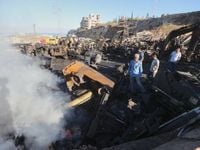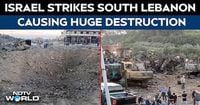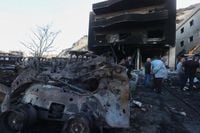In the early hours of October 11, 2025, the fragile calm along the Lebanon-Israel border shattered once again as Israeli warplanes unleashed a barrage of airstrikes on southern Lebanon, targeting the bustling heavy machinery yards along the Al-Msayleh road in the Nabatieh governorate. The attacks, which struck at dawn, left a trail of destruction, killing one person, injuring seven others, and igniting fresh outrage across the region.
According to Lebanon’s National News Agency (NNA), the Israeli assault began when a drone fired a guided missile at a car in the Qalaouiyah area of Bint Jbeil district, setting the vehicle ablaze and killing Ali Hussein Sultan, a resident of the nearby village of as-Sawana. This was not the only strike that day. Earlier, ten Israeli airstrikes had rained down on six heavy machinery yards between the Msayleh and an-Najjariyah districts, destroying a building, hundreds of vehicles, and leaving the key Al-Msayleh road impassable due to the extent of the damage.
Lebanon’s Health Ministry’s Public Health Emergency Operations Center confirmed the grim toll: one Syrian national killed, another Syrian and six Lebanese citizens wounded, including two women. The explosion of violence was especially devastating for those simply going about their daily lives. A vehicle carrying vegetables happened to be passing by at the time of the strikes, and it was hit—claiming the life of the Syrian driver and wounding another passenger, as reported by Hezbollah’s Al-Manar TV.
The physical destruction was staggering. Local media, including Anadolu and NNA, reported that more than 300 vehicles—bulldozers, excavators, and other heavy equipment—were obliterated in the inferno, with losses estimated in the hundreds of millions of dollars. The affected facilities, described as among the largest heavy machinery exhibition sites in Lebanon, were engulfed in flames, their buildings and tents reduced to rubble. The Al-Msayleh road, a vital artery linking Beirut with southern Lebanon, was completely severed, briefly isolating communities and complicating rescue efforts.
For many in Lebanon, the strikes represented more than just another round of violence in a long and bitter conflict. The timing was particularly sensitive. A ceasefire agreement, brokered in November 2024 after a grueling year-long war between Israel and Hezbollah, was meant to usher in a period of relative calm. Under the terms of the truce, Israel was supposed to withdraw fully from southern Lebanon by January 2025. But as of October, Israel still maintains a military presence at five border outposts—Labbouneh, Mount Blat, Owayda Hill, Aaziyyeh, and Hammamis Hill—despite repeated Lebanese demands for a complete pullout.
Hezbollah, the powerful Lebanese resistance movement, wasted no time in condemning the airstrikes. In a strongly worded statement, the group denounced what it called “Israeli aggression” and criticized the “silence of Arab and international actors regarding Tel Aviv’s continued attacks.” Hezbollah called on the Lebanese government to “adopt a resolute position, preserve national unity, take swift diplomatic measures, and file a formal complaint with the UN Security Council to halt the Zionist regime’s assaults.” The group stressed the need for solidarity and active engagement in Arab and global forums to pressure Israel to cease its attacks.
Lebanese President Joseph Aoun echoed these sentiments, describing the airstrikes as “a blatant act of aggression.” He warned, “The seriousness of this assault lies in the fact that it comes after the ceasefire agreement in Gaza,” and cautioned against what he saw as a possible Israeli attempt to transfer the conflict northward, toward Lebanon. The president’s words reflected a widespread fear in Lebanon that the violence in Gaza and southern Lebanon could become ever more deeply intertwined, with devastating consequences for civilians on both sides of the border.
International reaction was swift, if not always forceful. Tehran, a key supporter of Hezbollah, condemned what it described as the Israeli regime’s “recurrent acts of aggression against Lebanon, regardless of a 2024 ceasefire deal, as a blatant violation of the UN Charter and international principles.” Iranian Foreign Ministry spokesman Esmaeil Baghaei was blunt: “The Zionist regime’s repeated violations of the ceasefire agreement, and its military aggression against the territorial integrity and sovereignty of Lebanon constitute a clear violation of the United Nations Charter and international law.” Baghaei also criticized the inaction of the United States and France—guarantors of the ceasefire—calling for “serious and concerted action from the international community to curb the occupying regime’s lawlessness and warmongering against Lebanon and other countries in the West Asia region.”
The Israeli military, for its part, justified the strikes by claiming that the targeted machinery yards were being used to rebuild infrastructure for Hezbollah, which Israel considers a terrorist organization. “We struck and destroyed Hezbollah’s infrastructure in the area of southern Lebanon, where engineering equipment used to rebuild its infrastructure in the area was located,” the Israeli army said in a statement. Israeli officials have repeatedly accused Hezbollah of trying to reconstitute its capabilities after suffering heavy losses during the 14-month war.
The scars of that conflict are still raw. According to the World Bank, the war, which erupted in October 2023 after a Hamas-led incursion into southern Israel, killed more than 4,000 people in Lebanon—including hundreds of civilians—and caused an estimated $11 billion in destruction. In Israel, 127 people died, including 80 soldiers. The United Nations human rights chief, Volker Türk, recently called for renewed efforts to bring a permanent end to hostilities, noting that 103 civilians have been killed in Lebanon since the ceasefire took effect at the end of November 2024.
Despite the ceasefire, the border has remained tense, with almost daily Israeli airstrikes targeting what the military describes as Hezbollah infrastructure. Israeli drones were reported flying over Beirut and the city’s southern suburbs throughout the day of the attacks, heightening anxiety among residents who have grown accustomed to the persistent hum of surveillance overhead.
Meanwhile, the Lebanese government finds itself caught between the demands of its own citizens for security and stability, the pressures of international diplomacy, and the realities of a powerful neighbor to the south. Calls for a formal complaint to the UN Security Council have grown louder, but with little sign that the violence will abate anytime soon.
As the dust settles on yet another tragic day along the border, the people of southern Lebanon are left to pick up the pieces—physically, emotionally, and politically. The destruction of vital infrastructure and the loss of civilian life serve as stark reminders that, even after ceasefires and diplomatic agreements, peace remains an elusive goal in this troubled region.


